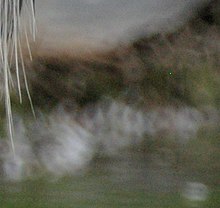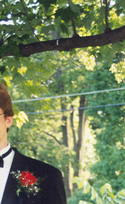Bokeh

In photography, bokeh is the blur,[1][2] or the æsthetic quality of the blur,[3][4][5] in out-of-focus areas of an image. Differences in lens aberrations and aperture shape cause some lens designs to blur the image in a way that is pleasing to the eye, while others produce blurring that is unpleasant or distracting— "good" or "bad" bokeh, respectively.[1] Bokeh occurs for parts of the scene that lie outside the depth of field. Photographers sometimes deliberately use a shallow focus technique to create images with prominent out-of-focus regions.
Bokeh is often most visible around small background highlights, such as specular reflections and light sources, which is why it often associated with such areas.[1] However, bokeh is not limited to highlights, as blur occurs in all out-of-focus regions of the image (see ostrich picture to the right).

Origin

The term comes from the Japanese word boke (暈け), which means "blur" or "haze". The English spelling bokeh was introduced in 1997 in Photo Techniques magazine, when Mike Johnston, the editor at the time, commissioned three papers on the topic for the March/April 1997 issue.[2] He altered the spelling to suggest the correct pronunciation to English speakers. It can be Template:Pron-en or /ˈboʊkə/ (boke-aay[6] or boke-uh[7]).
The term bokeh has appeared in photography books at least since 1998.[8]
Description


Although difficult to quantify, some lenses enhance overall image quality by producing more subjectively pleasing out-of-focus areas. Good bokeh is especially important for large-aperture lenses, macro lenses, and long telephoto lenses because they are typically used with a shallow depth of field. Bokeh is also important for medium telephoto "portrait lenses" (typically 85–150 mm on 35-mm format) because in portraiture photography, the photographer typically seeks to obtain a shallow depth of field to achieve an out-of-focus background and make the subject stand out.

Bokeh characteristics may be quantified by examining the image's circle of confusion. In out-of-focus areas, each point of light becomes an image of the aperture, generally a more or less round disc. Depending how a lens is corrected for spherical aberration, the disc may be uniformly illuminated, brighter near the edge, or brighter near the center. Lenses that are poorly corrected for spherical aberration will show one kind of disc for out-of-focus points in front of the plane of focus, and a different kind for points behind. This may actually be desirable, as blur circles that are dimmer near the edges produce less-defined shapes which blend smoothly with the surrounding image. Lens manufacturers including Nikon, Canon, and Minolta make lenses designed with specific controls to change the rendering of the out-of-focus areas.

The shape of the aperture has a great influence on the subjective quality of bokeh. When a lens is stopped down to something other than its maximum aperture size (minimum f-number), out-of-focus points are blurred into the polygonal shape of the aperture rather than perfect circles. This is most apparent when a lens produces undesirable, hard-edged bokeh, therefore some lenses have aperture blades with curved edges to make the aperture more closely approximate a circle rather than a polygon. Lens designers can also increase the number of blades to achieve the same effect. Traditional "Portrait" lenses, such as the "fast" 85mm focal length models for 35mm cameras often feature almost circular aperture diaphragms, as is the case with Canon's EF 85mm f/1.2L II lens and Nikon's 85mm f/1.4D, and are generally considered exceptional performers. A catadioptric telephoto lens displays bokehs resembling doughnuts, because its secondary mirror blocks the central part of the aperture opening.
Leica lenses, especially vintage ones, are often claimed to excel in bokeh quality, although Leica photographers have tended to make more use of maximum aperture due to the lenses' ability to maintain good sharpness at wide openings and the suitability of the Leica camera system for available-light theatre work and reportage. Consequently, more evidence is needed to determine whether Leica's lens designers deliberately set out to produce pleasing bokeh.
Minolta/Sony STF 135mm f/2.8 [T4.5]* (STF standing for Smooth Transition Focus) is a lens which is specifically designed to produce pleasing bokeh. An apodization filter is used to soften the aperture edges which results in a smooth defocused area with gradually fading circles. Those qualities make it the only lens of this kind currently on the market.

Recently, a research group at MIT Media Lab showed that the bokeh effect can be used to make imperceptibly small barcodes, or bokodes. By using markers as small as 2.5 microns, if the marker is viewed out of focus through an ordinary camera, the resulting bokeh is large enough to scan the information in the barcode.[9]
Emulation

Bokeh can be simulated by convolving the image with a kernel that corresponds to the image of an out-of-focus point source taken with a real camera. Diffraction may alter the effective shape of the blur. Some graphics editors have a filter to do this, usually called "Lens Blur",[10]. It can also be simulated using the Quartz Composer Defocus filter in Mac OS X Leopard, though Gaussian blur is often used to save time or when realistic bokeh is not required.
See also
- Circle of confusion
- Airy disk
- Aberration in optical systems
- Special effect
- Soft focus
- Kim Kirkpatrick, a photographer known for his creative use of bokeh
References
- ^ a b c Harold Davis (2008). Practical Artistry: Light & Exposure for Digital Photographers. O'Reilly Media. p. 62. ISBN 9780596529888.
- ^ a b Johnston, Mike (2004) The Sunday Morning Photographer, April 4, 2004: Bokeh in Pictures. The Luminous Landscape. Retrieved on July 3, 2009.
- ^ Gerry Kopelow (1998). How to photograph buildings and interiors (2nd ed.). Princeton Architectural Press. p. 118–119. ISBN 9781568980973.
- ^ Roger Hicks and Christopher Nisperos (2000). Hollywood Portraits: Classic Shots and How to Take Them. Amphoto Books. p. 132. ISBN 9780817440206.
- ^ Tom Ang (2002). Dictionary of Photography and Digital Imaging: The Essential Reference for the Modern Photographer. Watson–Guptill. ISBN 0817437894.
- ^ Merklinger, Harold (1997) Understanding Boke. The Luminous Landscape. Retrieved on July 3, 2009.
- ^ Wes McDermott (2009). Real World Modo: The Authorized Guide: In the Trenches with Modo. Focal Press. p. 198. ISBN 9780240811994.
- ^ Gerry Kopelow (1998). How to photograph buildings and interiors (2nd ed.). Princeton Architectural Press. p. 118–119. ISBN 9781568980973.
- ^ Mohan, A., Woo, G, Hiura, S, Smithwick, Q, Raskar, R. Bokode: Imperceptible Visual Tags for Camera Based Interaction from a Distance. ACM SIGGRAPH 2009.
- ^ Adobe Photoshop CS3 Livedocs. "Add lens blur".
{{cite web}}: CS1 maint: numeric names: authors list (link)
External links
- Aperture Simulator Java iris and effect simulator
- How to evaluate bokeh
- Understanding Bokeh
